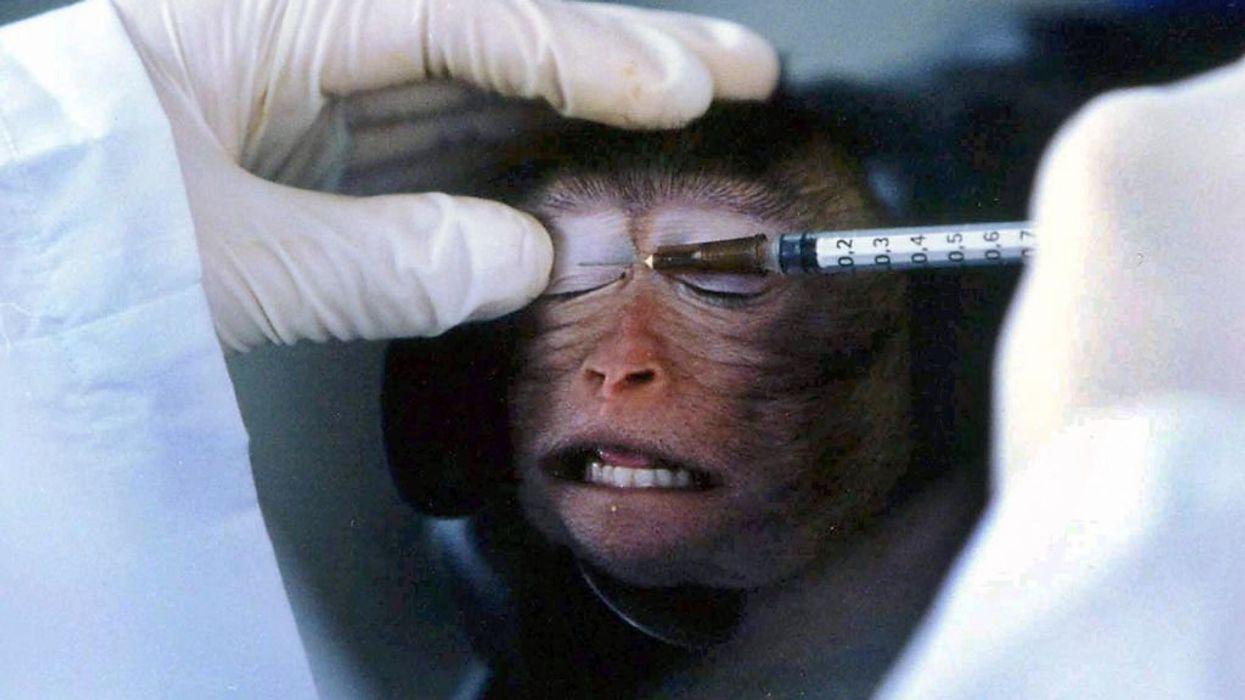
Glowing monkey not pictured. STR/AFP via Getty Images

Chinese scientists continue to meddle with animal genetics, undeterred by recent internationally consequential mishaps. Rather than create another chimeric virus, a team from the Chinese Academy of Science has instead created a chimeric monkey with an eerie glow.
Researchers published their findings in the experimental biology journal Cell on Thursday, revealing that they had produced a substantially "chimeric monkey" with luminous fingertips and fluorescent green eyes.
The significance of the experiment was not the short-lived creature's nightclub features, but rather what the green luminescence signified: It was the most chimeric live primate produced to date, using the stem cells of two different fertilized eggs from the same species.
In other words the monkey, a long-tailed macaque, had two sets of DNA deriving from more than one set of parents.
Researchers cultured nine stem cell lines using cells extracted from a week-old monkey embryo and altered them to ensure that they were pluripotent — able to differentiate into all the cells necessary to create a live animal. The scientists then introduced a fluorescent green protein to the stem cells in order to track which tissues had derived from these lines.
These stem cells were injected into monkey embryos, which were in turn implanted into female macaques, resulting in 12 pregnancies and six live births. Of these, one live-born monkey and one miscarried monkey were found to be substantially chimeric.
The chimerical nature of the monkey that briefly survived outside the womb was evidenced by the green stain found in the various cells and tissue throughout its body, including in its brain, heart, kidneys, testicles, and gut.
Whereas in previous studies, chimeric monkeys have contained limited donor cell contributions to between 0.1% and 4.5% of their tissues, the range this time was from a low of 21% all the way up to 92%, representing a major breakthrough.
The chimera didn't glow for long. After 10 days, the macaque's health "deteriorated with respiratory failure and hypothermia, and it was euthanized by a veterinarian."
The apparent breakthrough could reportedly pave the way for the generation of animals with specific human-like characteristics tailored to the testing of medicines and drugs.
"This is a long-sought goal in the field," said senior author Zhen Liu, reported EurekaAlert.
"This research not only has implications for understanding naive pluripotency in other primates, including humans, but it also has relevant practical implications for genetic engineering and species conservation," continued Zhen. "Specifically, this work could help us to generate more precise monkey models for studying neurological diseases as well as for other biomedicine studies."
Study coauthor Miguel Esteban, principal investigator at the Guangzhou Institute of Biomedicine and Health, told CNN, "It is encouraging that our live birth monkey chimera had a big contribution (of stem cells) to the brain, suggesting that indeed this approach should be valuable for modeling neurodegenerative diseases."
"Monkey chimeras also have potential enormous value for species conservation if they could be achieved between two types of nonhuman primate species, one of which is endangered," added Esteban. "If there is contribution of the donor cells from the endangered species to the germ line, one could envisage that through breeding animals of these species could be produced."
Like Blaze News? Bypass the censors, sign up for our newsletters, and get stories like this direct to your inbox. Sign up here!